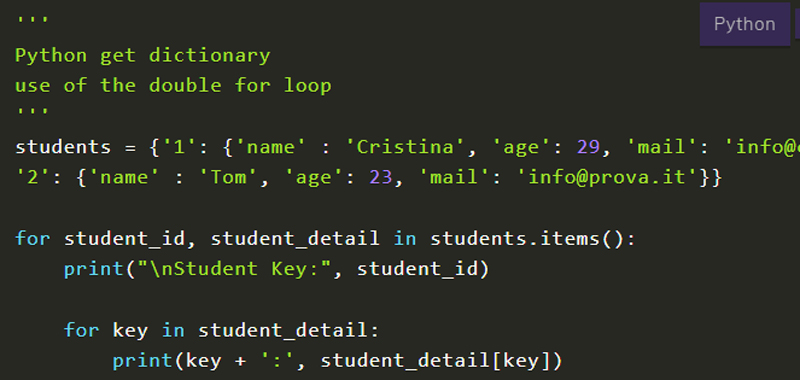In this lesson we will study a Python method, get(), for use on a dictionary.
The Python get() method returns the value of the specified key, if it exists in the dictionary. If the key does not exist it will return None (if get () is used with only one argument).
The syntax is as follows:
d.get(key, value)
Where is it:
key – represents the name of the key of the element from which we want to return the value.
value – optional, is the value to return if the key is not found. By default it is None.
Example of using Python get dictionary
Let’s see a very simple example of use. Suppose we have the following dictionary:
student = {'name': 'Cristina', 'age': 20, 'mail': 'info@codingcreativo.it'}
Then we use the get method on this dictionary to print the student’s name.
print(student.get('name'))
Now let’s try to print a key that doesn’t exist:
print(student.get('surname'))
If you try the code in the online compiler that you find at the following link: compiler online Python you can see that None will be returned.
Potremmo stampare un messaggio differente, come nel seguente esempio:
print(student.get('surname', 'The surname was not found'))
Using the Python get method nested in dictionary
Let’s now take another example of using the get method on dictionaries in Python. In this example we will use a dictionary where the key is numeric while the value is represented by another dictionary.
We select the name of only one student.
students = {'1': {'name' : 'Cristina', 'age': 29, 'mail': 'info@codingcreativo.it'},'2': {'name' : 'Tom', 'age': 23, 'mail': 'info@prova.it'}}
student = student.get('1', {}).get('name')
print(student)
Now we print all the student names with a loop, always using the get () method we just studied:
students = {'1': {'name' : 'Cristina', 'age': 29, 'mail': 'info@codingcreativo.it'},'2': {'name' : 'Tom', 'age': 23, 'mail': 'info@prova.it'}}
for student in students.values():
print(student.get('name'))
What if we want to print everything?
We could use 2 for loops, as in the example below:
'''
Python get dictionary
use of the double for loop
'''
students = {'1': {'name' : 'Cristina', 'age': 29, 'mail': 'info@codingcreativo.it'},
'2': {'name' : 'Tom', 'age': 23, 'mail': 'info@prova.it'}}
for student_id, student_detail in students.items():
print("\nStudent Key:", student_id)
for key in student_detail:
print(key + ':', student_detail[key])
Try these solutions in the online compiler that you will find at this link: online python compiler. The link will open on a new page so you can write the code.
Conclusion
In this lesson we studied Python get() method and saw how it can be applied to our dictionary exercises. In the next lessons there will be many other examples of use of this method and many others.
Some useful links
How to find the maximum of N numbers

